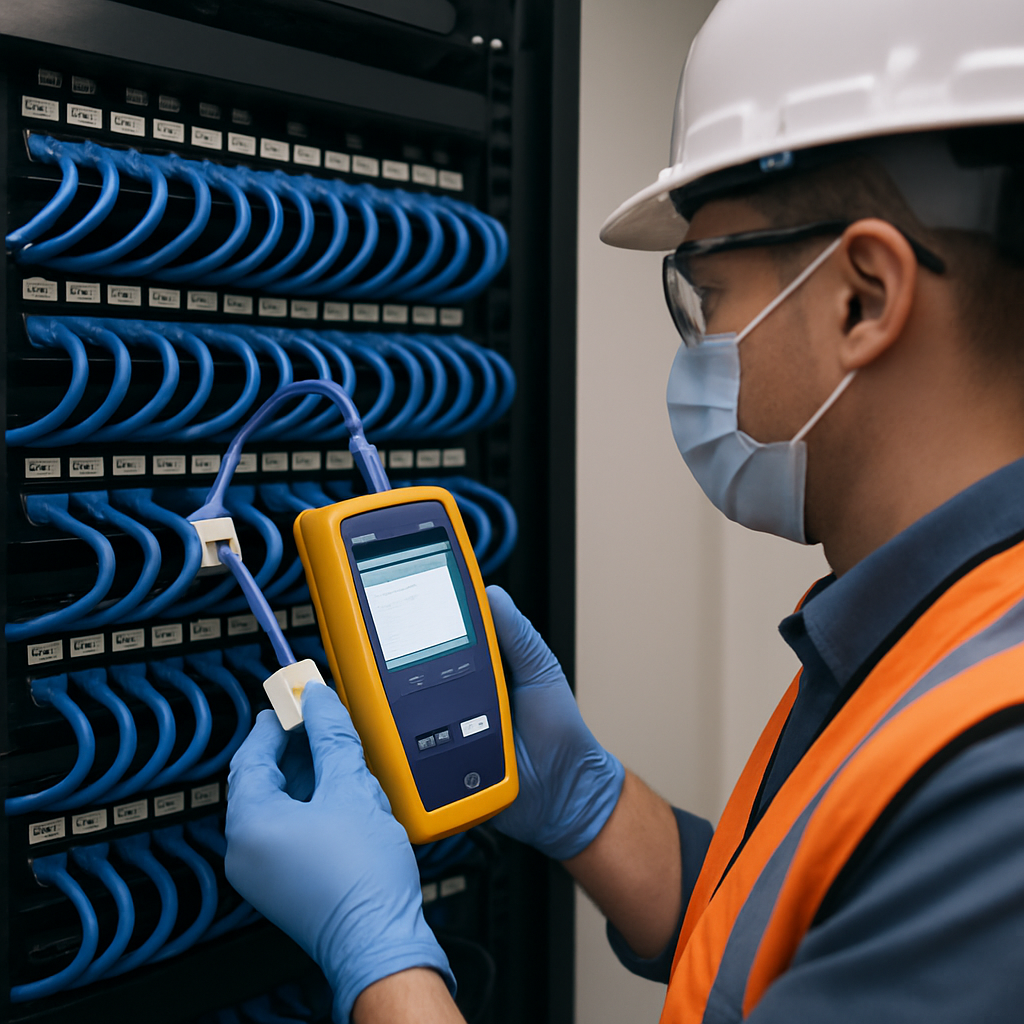Structured Cabling Performance Testing: A Guide for IT Leaders
Your school district or library has just invested in a network infrastructure upgrade. The new cabling installation is complete, and now the critical...
7 min read
 Kevin Murphy
:
Oct 6, 2025 6:00:00 AM
Kevin Murphy
:
Oct 6, 2025 6:00:00 AM
A high-performance network is built on thousands of precise details, but few are more critical than the termination point. A flawless cable run can be instantly compromised by a single poor connection, leading to signal loss, intermittent connectivity, and hours of frustrating troubleshooting. For cabling technicians and IT infrastructure professionals, mastering structured cabling termination techniques is the foundation of a reliable, high-speed network. An improper crimp or a rushed punch-down can degrade performance in ways that are difficult to diagnose after the fact.
At Turn-Key Technologies, with decades of experience designing and installing complex data networking systems, we’ve seen firsthand how termination practices make or break a project. This technical guide moves beyond the basics to detail the methods, tools, and standards required for terminating copper and fiber optic cables correctly the first time.
A cable termination is a critical transition that preserves the electrical characteristics of the entire cable run. When done correctly, it ensures signal integrity and long-term physical durability. When done poorly, it becomes the network’s weakest link, introducing performance issues that undermine the investment in high-quality cabling.
The twisted-pair design of an Ethernet cable is engineered to cancel out electromagnetic interference. When you terminate a cable, you must untwist the pairs to fit them into a connector or patch panel. According to the Telecommunications Industry Association (TIA) TIA-568 standards, untwisting the copper conductors more than 0.5 inches (13 mm) for Category 6A can introduce significant crosstalk, where the signal from one pair bleeds into another. This performance degradation, known as Near-End Crosstalk (NEXT), can cause data errors and retransmissions, slowing down the entire network connection.
A proper termination creates a solid, stable mechanical and electrical connection. For an RJ45 connector, a quality crimping tool ensures that the insulation-displacement contacts fully pierce the wire insulation and make firm contact with the copper conductor. Similarly, a punch-down tool must seat the conductor securely within the terminal block. A weak or loose connection can lead to microscopic gaps that cause signal reflections (return loss) or intermittent failures as physical conditions like temperature and vibration change over time.
The TIA defines two wiring schemes for RJ45 connectors: T568A and T568B. While electrically identical, T568B is the more dominant standard in commercial installations in the U.S. The most important rule is to maintain consistency; choosing one standard and applying it uniformly across all patch panels, jacks, and patch cords is essential for straightforward installations and troubleshooting. Mixing standards within the same cable run will result in a non-functional link.
Using professional-grade tools is non-negotiable for achieving compliant, reliable terminations. Consumer-grade tools often lack the precision needed for high-performance cabling, leading to damaged conductors, incomplete crimps, and failed connections. Investing in the right equipment saves time, reduces waste, and ensures every termination meets performance specifications.
The toolkit for terminating Ethernet cable focuses on precision and consistency. A quality cable stripper should have an adjustable blade to score the outer jacket without nicking the insulation of the inner conductors. For terminating RJ45 plugs, a pass-through crimper is highly recommended; it allows the wires to pass completely through the connector, making it easy to verify the color code before crimping and trimming the excess wire in one action. For patch panels and keystone jacks, a 110-style impact punch-down tool with a sharp blade is essential for seating conductors and cleanly trimming the excess.
Terminating fiber optic cables requires an even higher degree of precision and specialized tools. High-quality three-hole fiber strippers are used to remove the 900µm buffer, 250µm coating, and 125µm cladding without damaging the delicate glass fiber. The most critical tool is a precision cleaver, which scores and breaks the fiber to create a perfectly flat end-face perpendicular to the axis of the fiber. An improper cleave is a primary cause of high signal loss, so investing in a quality cleaver is crucial for anyone performing fusion splicing or installing mechanical connectors.
For most network infrastructure, technicians will spend the majority of their time terminating copper cables at the patch panel and the wall outlet. Mastering the punch-down for fixed connections and the RJ45 crimp for patch cords are the two most fundamental skills in a successful structured cabling installation. Both termination methods require attention to detail, especially regarding pair twist rates and color codes.
To terminate an RJ45 connector, first strip about 1.5 inches of the outer jacket, being careful not to damage the inner conductors. Separate the four twisted pairs and arrange them according to the T568B wiring standard (Orange-White, Orange, Green-White, Blue, Blue-White, Green, Brown-White, Brown). Carefully flatten and align the conductors before sliding them into a pass-through RJ45 connector, ensuring they reach the end in the correct order. Finally, use a pass-through crimping tool to securely seat the pins and trim the excess wire flush with the connector face.
Punch-down terminations are used for horizontal cable runs connecting patch panels to wall jacks. After stripping the cable jacket, fan out the twisted pairs and lay them into the corresponding color-coded Insulation Displacement Connector (IDC) slots, keeping the pairs twisted as close to the slot as possible. Use a 110-impact tool set to the correct pressure to push the conductor into the IDC slot; the slot’s blades slice through the insulation to make contact with the copper. On a recent data center project, our team diagnosed intermittent connectivity on several ports; the issue was traced to the previous installer using a dull punch-down blade, which failed to properly seat the conductors, causing a poor connection.
Terminating fiber optic cable is a delicate process where the primary goal is to align two microscopic glass cores with near-perfect precision to minimize signal loss (measured in decibels). The method chosen often depends on the application, budget, and the skill of the installer. While fusion splicing offers the best performance, other techniques are suitable for field repairs or lower-bandwidth applications.
A mechanical splice connector is a field-installable device that quickly joins two cleaved fibers. Inside the connector, a small amount of index-matching gel helps bridge the microscopic air gap between the two fiber ends, reducing signal reflection and loss. While they are faster to install and require less expensive equipment than fusion splicing, they typically have a higher insertion loss (0.2dB to 0.75dB). This makes them a great option for emergency repairs or in applications where a small amount of signal loss is acceptable.
Fusion splicing is the gold standard for permanent fiber optic terminations, delivering the lowest loss and highest reliability. The process uses a fusion splicer machine to precisely align two cleaved fibers and then applies an electric arc to melt and permanently fuse them together. The resulting connection has a typical insertion loss of less than 0.05dB, creating an almost seamless optical path. This method is preferred for long-haul backbones and data center interconnects where preserving signal strength is paramount.
This is a more traditional field termination method that involves gluing a fiber into a connector ferrule with epoxy and then polishing the fiber tip to a smooth, flat finish using special polishing films. While this technique can produce very low-loss, high-performance connections when performed by a skilled technician, it is labor-intensive and time-consuming. As of 2025, it has largely been replaced in the field by pre-polished mechanical connectors and fusion splice-on connectors for their speed and consistency.
A cable termination is not truly complete until it has been thoroughly tested and verified. Testing ensures that the connection meets industry performance standards and will reliably support the intended applications. Skipping this final quality assurance step is a common mistake that can lead to significant network problems down the road, transforming a minor installation error into a major operational headache. Properly understanding structured cabling means recognizing that testing is an integral part of the installation process itself.
The most basic form of testing is a wiremap test, which confirms end-to-end continuity and checks for common wiring faults. A simple wiremap tester checks that each pin on one end of the cable is correctly connected to the corresponding pin on the other end. It will immediately identify issues like open circuits (a broken wire), shorts (two wires touching), reversed pairs, crossed pairs, and split pairs, which are some of the most common errors in manual RJ45 terminations.
For networks that require guaranteed performance for applications like 10 Gigabit Ethernet, certification is mandatory. A cable certifier, such as a Fluke Networks CableAnalyzer, performs a series of advanced tests to measure performance against specific TIA or ISO standards. This goes far beyond a simple wiremap, measuring critical parameters such as NEXT, return loss, insertion loss, and alien crosstalk across the entire frequency spectrum. According to organizations like BICSI that set professional standards, certification is the only way to prove that a cabling installation meets the performance requirements for its category rating.
Precision, proper tools, and adherence to standards are the pillars of reliable cable termination. Whether it’s a copper punch-down on a patch panel or a fusion splice on a fiber backbone, every connection contributes to the overall health and performance of your network infrastructure. Taking the time to master these techniques ensures long-term reliability and saves countless hours of future troubleshooting.
If your team needs to elevate its cabling skills from good to great, expert-led instruction can make all the difference. Turn-Key Technologies offers customized, hands-on workshops that cover the best practices for both copper and fiber termination.
Ensure your installations meet the highest standards. Request onsite termination training with our experienced professionals today.
Turn‑Key Technologies, Inc. (TTI) brings more than three decades of experience in engineering, installing, and certifying structured cabling systems. Our emphasis on full‑service support, standards‑based design (TIA‑568 and ISO/IEC 11801), and enterprise‑grade SLAs makes us a reliable partner for organizations with complex network requirements.
IT, facilities, and procurement teams count on TTI for terminations that pass certification the first time—and remain stable in production. We enforce best‑practice techniques at the endpoint: minimal pair untwist, proper strain relief, bend‑radius control, connector and patch‑panel selection matched to category, clear labeling, and 100% test documentation. From copper punch‑downs to fusion splice‑on connectors, we design and execute for long‑term scalability and warranty compliance.
Explore structured cabling case studies, termination how‑tos, and step‑by‑step checklists on our blog.

Kevin has been with Turn-key Technologies since 2012, overseeing cabling teams and managing projects from concept to completion. With deep expertise in structured cabling installations—including fiber optics, Cat5/5e/6/6a, and coax systems—he works closely with clients and engineers to deliver reliable, high-quality solutions on time and on budget.
Certifications:
NJ Division of Consumer Affairs
• Uniform & Construction Code
• Residential Fire Alarm Systems
• Smoke Detection Systems
• NJ Barrier Free Subcode
• ADA & Licensing Law
NYS Licenses
• Security & Fire Alarm License
• Electrical Training Center Fire Alarm Certification
BICSI & Technical
• Designing for PoE Lighting
• Fiber Optic & Connector Termination
• Firestop 101
Other Certifications
• OSHA 30-Hour Construction Safety
• Verkada Certified Engineer
• Avigilon Access Control Manager 6

Your school district or library has just invested in a network infrastructure upgrade. The new cabling installation is complete, and now the critical...

4 min read
A disorganized data center rack full of tangled network cable runs is a direct liability to your network's stability. When cables used for...

4 min read
Your company is growing. You’re hiring new staff, adopting new technologies, and expanding your operational footprint. But can your network...